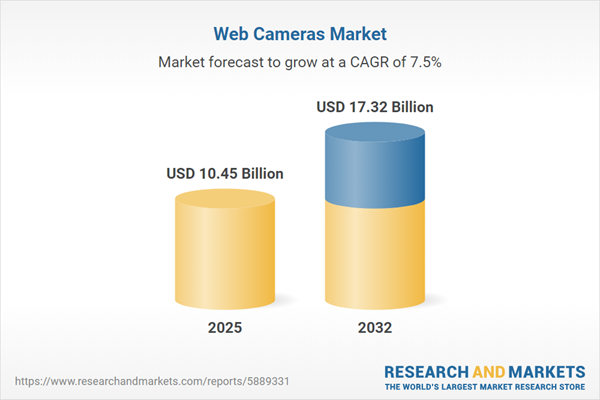Speak directly to the analyst to clarify any post sales queries you may have.
The global web camera market continues to evolve as enterprises seek secure, high-quality video solutions tailored to dynamic workplace demands. Senior leaders require technology that balances operational resilience, scalability, and seamless digital collaboration for modern business continuity.
Market Snapshot: Global Web Camera Market Size and Growth
The global web camera market reached USD 9.73 billion in 2024, with projections indicating expansion to USD 17.32 billion by 2032, representing a 7.47% CAGR. This upward trend is fueled by consistent investment in digital communication infrastructure across commercial, educational, and personal domains. Enterprises now prioritize interoperable video platforms and system integration to enable flexible, digitally connected workplaces, signifying a broader transition toward environments that emphasize collaboration and connectivity to support organizational agility.
Scope & Segmentation: In-Depth Analysis of the Web Camera Market
- Type: External web cameras provide versatile deployment, while integrated webcams allow simplified rollouts, supporting diverse IT strategies and enterprise requirements.
- Connectivity: Multiple interfaces—including IP, USB 2.0, USB 3.0, USB-C, Wi-Fi, and Bluetooth—support compatibility with various legacy and modern systems for easy device management and future upgrades.
- Distribution Channels: Organizations source web cameras through retail, specialty distribution, enterprise suppliers, and e-commerce, enabling tailored procurement approaches to align with operational processes.
- Resolution: Devices range from Full HD (1080P) to Ultra HD (4K), supporting applications from everyday conferencing and streaming to high-end content creation requirements across industries.
- Application: Web cameras are critical in executive conferencing, distance education, live event streaming, government communication, and project-driven collaboration across multiple sectors.
- End User: Adoption is widespread among large organizations, SMBs, home offices, and educational settings, with each group leveraging video technology to enhance engagement and streamline workflows.
- Technology: The use of CCD and CMOS sensors, along with 3D sensing technologies like structured light and time-of-flight, supports specialized use cases in healthcare, manufacturing, and digital media production.
- Form Factor: Clip-on, desktop-mounted, stand-alone, and PTZ (pan-tilt-zoom) cameras allow easy integration into a wide variety of business and educational environments.
- Regional Coverage: Accelerated uptake is noticeable in China, India, Japan, and Australia, with adoption patterns reflecting local digital transformation initiatives and distinct infrastructure priorities.
- Company Profiles: Industry leaders such as Logitech International, Ausdom Technology, Microsoft Corporation, Creative Technology, A4Tech, Razer, HP, Dell Technologies, Lenovo, and Xiaomi continue to shape innovation and technology standards within the market.
Key Takeaways for Senior Decision-Makers
- Integrated camera solutions support rapid scaling of digital collaboration, preserving workflow efficiency as organizations expand remote and hybrid operations.
- AI-driven features in web camera systems enable automation, aiding compliance and elevating data security standards in regulated sectors.
- Advanced privacy protocols, such as encryption and multi-factor authentication, help enterprises meet regulatory mandates involving sensitive information.
- Broad product ranges let organizations tailor deployments for sector-specific needs in healthcare, education, and more, helping to balance compliance and productivity goals.
- Strategic differences by region require adaptive market approaches—mature economies pursue advanced capabilities, while emerging markets focus on cost-efficiency and foundational infrastructure.
- Close integration among hardware, software, and cloud providers ensures technology investments align with enterprise objectives, supporting business resilience amid rapid change.
Tariff Impact: Addressing Policy Changes in the United States
Recent U.S. tariff adjustments have led many manufacturers to relocate production to Southeast Asia and Europe. This shift is prompting enterprises to strengthen supply chain strategies by diversifying their supplier base and adopting modular device platforms. These efforts enhance resilience against fluctuating trade policies and regulatory requirements.
Methodology & Data Sources
This analysis draws from structured interviews with industry veterans, key IT stakeholders, and supply chain partners, paired with validated company records and established third-party research. Independent analytical frameworks underpin both the market forecast and the evaluation of web camera solutions.
Why This Report Matters for Strategic Leaders
- Delivers actionable intelligence for developing secure, future-ready video communications strategies that reinforce digital resilience objectives.
- Supports fully informed procurement, risk management, and compliance planning by providing deep market and technology insights.
- Enables effective technology investment and strategic planning tailored to the shifting requirements of different sectors and operational contexts.
Conclusion
Adopting advanced video technologies within a robust partner ecosystem equips organizations to adapt and sustain effective collaboration as enterprise communication models continue to develop.
Additional Product Information:
- Purchase of this report includes 1 year online access with quarterly updates.
- This report can be updated on request. Please contact our Customer Experience team using the Ask a Question widget on our website.
Table of Contents
3. Executive Summary
4. Market Overview
7. Cumulative Impact of Artificial Intelligence 2025
Companies Mentioned
The companies profiled in this Web Cameras market report include:- Logitech International S.A.
- Ausdom Technology Co., Ltd.
- Microsoft Corporation
- Creative Technology Ltd.
- A4Tech Co., Ltd.
- Razer Inc.
- HP Inc.
- Dell Technologies Inc.
- Lenovo Group Limited
- Xiaomi Corporation
Table Information
| Report Attribute | Details |
|---|---|
| No. of Pages | 185 |
| Published | October 2025 |
| Forecast Period | 2025 - 2032 |
| Estimated Market Value ( USD | $ 10.45 Billion |
| Forecasted Market Value ( USD | $ 17.32 Billion |
| Compound Annual Growth Rate | 7.4% |
| Regions Covered | Global |
| No. of Companies Mentioned | 11 |









